Aboveground Biomass Mapping of Crops Supported by Improved CASA Model and Sentinel-2 Multispectral Imagery
Abstract
:1. Introduction
2. Materials and Methods
2.1. Study Area
2.2. Datasets and Processing
2.2.1. Meteorological Data
2.2.2. Remote Sensing Data
2.2.3. Measured Field Data
2.3. Methods
2.3.1. Processing Flow of the Original CASA Model
2.3.2. Vegetation Indices
2.3.3. Conversion of NPP into Aboveground Biomass
2.3.4. Accuracy Assessment
2.4. Workflow
3. Results
3.1. Modeling of FPAR Based on Red-Edge Vegetation Indices
3.2. FPAR Inversion Results Based on Red-Edge Vegetation Indices
3.3. Improved Inversion Results Based on Red-Edge Vegetation Indices
3.3.1. Cumulative NPP and Biomass of Crops
3.3.2. Aboveground Biomass Estimation Accuracy of Crops
3.4. Seasonal Variation and Factors Influencing Crops Aboveground Biomass
4. Discussion
4.1. Accuracy Differences of Various Vegetation Indices
4.2. Mapping Differences of Various Models
4.3. Features of Improved CASA Model
5. Conclusions
Author Contributions
Funding
Institutional Review Board Statement
Informed Consent Statement
Data Availability Statement
Acknowledgments
Conflicts of Interest
Abbreviations
| NPP | Net primary productivity | NPP = APAR × LUE |
| APAR | Photosynthetically active radiation absorbed by the vegetation canopy | APAR = PAR × FPAR |
| FPAR | Photosynthetically active radiation absorption proportion | FPARwheat = 0.8287 × NDVIred-edge + 0.1889 FPARmaize = 0.1023 × SRred-edge + 0.3011 |
| PAR | Photosynthetically active radiation | PAR = SOL × 0.5 |
| SOL | Monthly radiation | Defined as the total radiation of crops in main growth stage |
| LUE | Actual light use efficiency | LUE = Tε1 × Tε2 × Wε × LUEmax |
| LUEmax | Maximum LUE | For winter wheat, LUEmax = 1.95, for summer maize, LUEmax = 2.55 |
| Tε1 | Effects of temperature stress | Tε1 = 0.8 + 0.02 × Topt − 0.0005 × Topt2 |
| Tε2 | Effects of temperature stress | Tε2 = 1.184/{1 + exp [0.2 × (Topt-10-Tx)]} × 1/{1 + exp[0.3 × (−Topt-10 + Tx)]} |
| Topt | Optimal temperature | Defined as the air temperature in the month when the NDVI reaches its maximum |
| Tx | Monthly temperature | Defined as monthly temperature of crops in main growth stage |
| Wε | Effects of water stress | Wε = (1 − (1 + LSWI)/(1 + LSWImax)) + 0.5 |
| LSWI | Land Surface Water Index | LSWI = ()/() |
| B | Aboveground biomass | |
| Ratio of the aboveground biomass to the whole vegetation | For winter wheat, .90, for summer maize, .91, | |
| The C ratio of a crop | For winter wheat, .49, for summer maize, .47, | |
| NDVI | Normalized Difference Vegetation Index | |
| NDVIred-edge | Red-Edge Normalized Difference Vegetation Index | |
| Simple Ratio Vegetation Index | ||
| MSR | Modified Simple Ratio Vegetation Index | |
| MSRred-edge | Modified Red-Edge Simple Ratio Vegetation Index | |
| SRred-edge | Red-Edge Simple Ratio Vegetation Index | |
| EVI | Enhanced Vegetation Index |
References
- Schwalbert, R.A.; Amado, T.J.; Nieto, L.; Varela, S.; Corassa, G.M.; Horbe, T.A.; Rice, C.W.; Peralta, N.R.; Ciampitti, I.A. Forecasting maize yield at field scale based on high-resolution satellite imagery. Biosyst. Eng. 2018, 171, 179–192. [Google Scholar] [CrossRef]
- Li, B.; Xu, X.; Zhang, L.; Han, J.; Bian, C.; Li, G.; Liu, J.; Jin, L. Above-ground biomass estimation and yield prediction in potato by using UAV-based RGB and hyperspectral imaging. ISPRS J. Photogramm. Remote Sens. 2020, 162, 161–172. [Google Scholar] [CrossRef]
- Huang, J.; Ma, H.; Sedano, F.; Lewis, P.; Liang, S.; Wu, Q.; Su, W.; Zhang, X.; Zhu, D. Evaluation of regional estimates of winter wheat yield by assimilating three remotely sensed reflectance datasets into the coupled WOFOST–PROSAIL model. Eur. J. Agron. 2019, 102, 1–13. [Google Scholar] [CrossRef]
- Huang, J.; Sedano, F.; Huang, Y.; Ma, H.; Li, X.; Liang, S.; Tian, L.; Zhang, X.; Fan, J.; Wu, W. Assimilating a synthetic Kalman filter leaf area index series into the WOFOST model to improve regional winter wheat yield estimation. Agric. For. Meteorol. 2016, 216, 188–202. [Google Scholar] [CrossRef]
- Huang, J.; Gómez-Dans, J.L.; Huang, H.; Ma, H.; Wu, Q.; Lewis, P.E.; Liang, S.; Chen, Z.; Xue, J.-H.; Wu, Y. Assimilation of remote sensing into crop growth models: Current status and perspectives. Agric. For. Meteorol. 2019, 276, 107609. [Google Scholar] [CrossRef]
- Fang, P.; Zhang, X.; Wei, P.; Wang, Y.; Zhang, H.; Liu, F.; Zhao, J. The Classification Performance and Mechanism of Machine Learning Algorithms in Winter Wheat Mapping Using Sentinel-2 10 m Resolution Imagery. Appl. Sci.-Basel. 2020, 10, 5075. [Google Scholar] [CrossRef]
- Zhang, X.; Liu, J.; Qin, Z.; Qin, F. Winter wheat identification by integrating spectral and temporal information derived from multi-resolution remote sensing data. J. Integr. Agric. 2019, 18, 2628–2643. [Google Scholar] [CrossRef]
- Zhang, X.; Qiu, F.; Qin, F. Identification and mapping of winter wheat by integrating temporal change information and Kullback–Leibler divergence. Int. J. Appl. Earth Obs. Geoinf. 2019, 76, 26–39. [Google Scholar] [CrossRef]
- Lu, D. The potential and challenge of remote sensing-based biomass estimation. Int. J. Remote Sens. 2006, 27, 1297–1328. [Google Scholar] [CrossRef]
- He, M.; Kimball, J.S.; Maneta, M.P.; Maxwell, B.D.; Moreno, A.; Beguería, S.; Wu, X. Regional crop gross primary productivity and yield estimation using fused landsat-MODIS data. Remote Sens. 2018, 10, 372. [Google Scholar] [CrossRef] [Green Version]
- Goswami, S.; Gamon, J.; Vargas, S.; Tweedie, C. Relationships of NDVI, Biomass, and Leaf Area Index (LAI) for six key plant species in Barrow, Alaska. PeerJ PrePrints. 2015, 3, e913v1. [Google Scholar]
- Sun, Y.; Qin, Q.; Ren, H.; Zhang, T.; Chen, S. Red-edge band vegetation indices for leaf area index estimation from sentinel-2/msi imagery. IEEE Trans. Geosci. Remote Sens. 2019, 58, 826–840. [Google Scholar] [CrossRef]
- Huang, J.; Tian, L.; Liang, S.; Ma, H.; Becker-Reshef, I.; Huang, Y.; Su, W.; Zhang, X.; Zhu, D.; Wu, W. Improving winter wheat yield estimation by assimilation of the leaf area index from Landsat TM and MODIS data into the WOFOST model. Agric. For. Meteorol. 2015, 204, 106–121. [Google Scholar] [CrossRef] [Green Version]
- Huang, J.; Ma, H.; Su, W.; Zhang, X.; Huang, Y.; Fan, J.; Wu, W. Jointly assimilating MODIS LAI and ET products into the SWAP model for winter wheat yield estimation. IEEE J. Sel. Top. Appl. Earth Obs. Remote Sens. 2015, 8, 4060–4071. [Google Scholar] [CrossRef]
- Boelman, N.T.; Stieglitz, M.; Rueth, H.M.; Sommerkorn, M.; Griffin, K.L.; Gamon, S.J.A. Response of NDVI, biomass, and ecosystem gas exchange to long-term warming and fertilization in wet sedge tundra. Oecologia 2003, 135, 414–421. [Google Scholar] [CrossRef] [PubMed]
- Marshall, M.; Thenkabail, P. Developing in situ non-destructive estimates of crop biomass to address issues of scale in remote sensing. Remote Sens. 2015, 7, 808–835. [Google Scholar] [CrossRef] [Green Version]
- Zheng, Y.; Wu, B.F.; Zhang, M. Estimating the above ground biomass of winter wheat using the Sentinel-2 data. J. Remote Sens. 2017, 21, 318–328. [Google Scholar]
- Kross, A.; McNairn, H.; Lapen, D.; Sunohara, M.; Champagne, C. Assessment of RapidEye vegetation indices for estimation of leaf area index and biomass in corn and soybean crops. Int. J. Appl. Earth Obs. Geoinf. 2015, 34, 235–248. [Google Scholar] [CrossRef] [Green Version]
- Frampton, W.J.; Dash, J.; Watmough, G.; Milton, E.J. Evaluating the capabilities of Sentinel-2 for quantitative estimation of biophysical variables in vegetation. ISPRS J. Photogramm. 2013, 82, 83–92. [Google Scholar] [CrossRef] [Green Version]
- Du, X.; Meng, J.; Wu, B. Overview on Monitoring Crop Biomass with Remote Sensing. Spectrosc. Spectr. Anal. 2010, 30, 3098–3102. [Google Scholar]
- Monteith, J. Solar radiation and productivity in tropical ecosystems. J. Appl. Ecol. 1972, 9, 747–766. [Google Scholar] [CrossRef] [Green Version]
- Potter, C.S.; Randerson, J.T.; Field, C.B.; Matson, P.A.; Vitousek, P.M.; Mooney, H.A.; Klooster, S.A. Terrestrial ecosystem production: A process model based on global satellite and surface data. Global Biogeochem. Cycles. 1993, 7, 811–841. [Google Scholar] [CrossRef]
- Bao, G.; Bao, Y.; Qin, Z.; Xin, X.; Bao, Y.; Bayarsaikan, S.; Zhou, Y.; Chuntai, B. Modeling net primary productivity of terrestrial ecosystems in the semi-arid climate of the Mongolian Plateau using LSWI-based CASA ecosystem model. Int. J. Appl. Earth Obs. Geoinf. 2016, 46, 84–93. [Google Scholar] [CrossRef]
- Liu, Z.; Zhang, X.; Chen, Y.; Zhang, C.; Qin, F.; Zeng, H. Remote sensing estimation of biomass in winter wheat based on CASA model at region scale. Trans. Chin. Soc. Agric. Eng. 2017, 33, 225–233. [Google Scholar]
- Tao, F.; Yokozawa, M.; Zhang, Z.; Xu, Y.; Hayashi, Y. Remote sensing of crop production in China by production efficiency models: Models comparisons, estimates and uncertainties. Ecol. Modell. 2005, 183, 385–396. [Google Scholar] [CrossRef]
- Angstrom, A. Solar and terrestrial radiation. Report to the international commission for solar research on actinometric investigations of solar and atmospheric radiation. Q. J. R. Meteorolog. Soc. 1924, 50, 121–126. [Google Scholar] [CrossRef]
- Almorox, J.; Hontoria, C.J.E.C. Global solar radiation estimation using sunshine duration in Spain. Energy Convers. Manag. 2004, 45, 1529–1535. [Google Scholar] [CrossRef]
- Drusch, M.; Del Bello, U.; Carlier, S.; Colin, O.; Fernandez, V.; Gascon, F.; Hoersch, B.; Isola, C.; Laberinti, P.; Martimort, P. Sentinel-2: ESA’s optical high-resolution mission for GMES operational services. Remote Sens. Environ. 2012, 120, 25–36. [Google Scholar] [CrossRef]
- Forkuor, G.; Dimobe, K.; Serme, I.; Tondoh, J.E. Landsat-8 vs. Sentinel-2: Examining the added value of sentinel-2’s red-edge bands to land-use and land-cover mapping in Burkina Faso. GISci. Remote Sens. 2018, 55, 331–354. [Google Scholar] [CrossRef]
- Vrieling, A.; Meroni, M.; Darvishzadeh, R.; Skidmore, A.K.; Wang, T.; Zurita-Milla, R.; Oosterbeek, K.; O’Connor, B.; Paganini, M. Vegetation phenology from Sentinel-2 and field cameras for a Dutch barrier island. Remote Sens. Environ. 2018, 215, 517–529. [Google Scholar] [CrossRef]
- Du, Y.; Zhang, Y.; Ling, F.; Wang, Q.; Li, W.; Li, X. Water bodies’ mapping from Sentinel-2 imagery with modified normalized difference water index at 10-m spatial resolution produced by sharpening the SWIR band. Remote Sens. 2016, 8, 354. [Google Scholar] [CrossRef] [Green Version]
- Shelestov, A.; Lavreniuk, M.; Kussul, N.; Novikov, A.; Skakun, S. Exploring Google earth engine platform for big data processing: Classification of multi-temporal satellite imagery for crop mapping. Front. Earth Sci. 2017, 5, 17. [Google Scholar] [CrossRef] [Green Version]
- Gorelick, N.; Hancher, M.; Dixon, M.; Ilyushchenko, S.; Thau, D.; Moore, R. Google Earth Engine: Planetary-scale geospatial analysis for everyone. Remote Sens. Environ. 2017, 202, 18–27. [Google Scholar] [CrossRef]
- Aneece, I.; Thenkabail, P. Accuracies achieved in classifying five leading world crop types and their growth stages using optimal earth observing-1 hyperion hyperspectral narrowbands on google earth engine. Remote Sens. 2018, 10, 2027. [Google Scholar] [CrossRef] [Green Version]
- Yang, W.; Tan, B.; Huang, D.; Rautiainen, M.; Shabanov, N.V.; Wang, Y.; Privette, J.L.; Huemmrich, K.F.; Fensholt, R.; Sandholt, I. MODIS leaf area index products: From validation to algorithm improvement. IEEE Trans. Geosci. Remote Sens. 2006, 44, 1885–1898. [Google Scholar] [CrossRef]
- Claverie, M.; Matthews, J.L.; Vermote, E.F.; Justice, C.O. A 30+ year AVHRR LAI and FAPAR climate data record: Algorithm description and validation. Remote Sens. 2016, 8, 263. [Google Scholar] [CrossRef] [Green Version]
- Ruimy, A.; Saugier, B.; Dedieu, G. Methodology for the estimation of terrestrial net primary production from remotely sensed data. J. Geophys. Res. Atmos. 1994, 99, 5263–5283. [Google Scholar] [CrossRef]
- Yan, H.; Fu, Y.; Xiao, X.; Huang, H.Q.; He, H.; Ediger, L. Modeling gross primary productivity for winter wheat–maize double cropping system using MODIS time series and CO2 eddy flux tower data. Agric. Ecosyst. Environ. 2009, 129, 391–400. [Google Scholar] [CrossRef]
- Xiao, X.; Zhang, Q.; Braswell, B.; Urbanski, S.; Boles, S.; Wofsy, S.; Iii, B.M.; Ojima, D. Modeling gross primary production of temperate deciduous broadleaf forest using satellite images and climate data. Remote Sens. Environ. 2004, 91, 256–270. [Google Scholar] [CrossRef]
- Hatfield, J.; Asrar, G.; Kanemasu, E.T. Intercepted photosynthetically active radiation estimated by spectral reflectance. Remote Sens. Environ. 1984, 14, 65–75. [Google Scholar] [CrossRef]
- Jordan, C.F. Derivation of leaf-area index from quality of light on the forest floor. Ecology 1969, 50, 663–666. [Google Scholar] [CrossRef]
- Sims, D.A.; Gamon, J.A. Relationships between leaf pigment content and spectral reflectance across a wide range of species, leaf structures and developmental stages. Remote Sens. Environ. 2002, 81, 337–354. [Google Scholar] [CrossRef]
- Gitelson, A.A. Wide dynamic range vegetation index for remote quantification of biophysical characteristics of vegetation. J. Plant Physiol. 2004, 161, 165–173. [Google Scholar] [CrossRef] [PubMed] [Green Version]
- Wu, C.; Niu, Z.; Tang, Q.; Huang, W. Estimating chlorophyll content from hyperspectral vegetation indices: Modeling and validation. Agric. For. Meteorol. 2008, 148, 1230–1241. [Google Scholar] [CrossRef]
- Gitelson, A.A.; Merzlyak, M.N. Remote estimation of chlorophyll content in higher plant leaves. Int. J. Remote Sens. 1997, 18, 2691–2697. [Google Scholar] [CrossRef]
- Tucker, C.J.; Pinzon, J.E.; Brown, M.E.; Slayback, D.A.; Pak, E.W.; Mahoney, R.; Vermote, E.F.; El Saleous, N. An extended AVHRR 8-km NDVI dataset compatible with MODIS and SPOT vegetation NDVI data. Int. J. Remote Sens. 2005, 26, 4485–4498. [Google Scholar] [CrossRef]
- Tong, X.; Li, j.; Yu, Q. Analysis of Bio-physical Controls on Light Use Efficiency in a Farmland Ecosystem. J. Nat Resour. 2009, 24, 1393–1401. [Google Scholar]
- Ren, J.; Liu, X.; Chen, Z.; Zhou, Q.; Tang, H. Prediction of winter wheat yield based on crop biomass estimation at regional scal. J. Appl Ecol. 2009, 20, 872–878. [Google Scholar]
- Pearcy, R.; Ehleringer, J. Comparative ecophysiology of C3 and C4 plants. Plant Cell Environ. 1984, 7, 1–13. [Google Scholar] [CrossRef]
- Mutanga, O.; Skidmore, A.K. Narrow band vegetation indices overcome the saturation problem in biomass estimation. Int. J. Remote Sens. 2004, 25, 3999–4014. [Google Scholar] [CrossRef]
- Sellers, P. Canopy reflectance, photosynthesis, and transpiration, II. The role of biophysics in the linearity of their interdependence. Remote Sens. Environ. 1987, 21, 143–183. [Google Scholar] [CrossRef]
- Lin, S.; Li, J.; Liu, Q.; Li, L.; Zhao, J.; Yu, W. Evaluating the effectiveness of using vegetation indices based on red-edge reflectance from Sentinel-2 to estimate gross primary productivity. Remote Sens. 2019, 11, 1303. [Google Scholar] [CrossRef] [Green Version]
- Gitelson, A.A.; Viña, A.; Verma, S.B.; Rundquist, D.; Arkebauer, T.J.; Keydan, G.; Leavitt, B.; Ciganda, V.; And, G.; Suyker, A.E. Relationship between gross primary production and chlorophyll content in crops: Implications for the synoptic monitoring of vegetation productivity. J. Geophys. Res.-Atmos. 2006, 111, D08S11. [Google Scholar] [CrossRef] [Green Version]
- Yan, K.; Park, T.; Yan, G.; Chen, C.; Yang, B.; Liu, Z.; Nemani, R.; Knyazikhin, Y.; Myneni, R. Evaluation of MODIS LAI/FPAR Product Collection 6. Part 1: Consistency and Improvements. Remote Sens. 2016, 8, 359. [Google Scholar] [CrossRef] [Green Version]
- Yan, K.; Park, T.; Yan, G.; Liu, Z.; Yang, B.; Chen, C.; Nemani, R.; Knyazikhin, Y.; Myneni, R. Evaluation of MODIS LAI/FPAR Product Collection 6. Part 2: Validation and Intercomparison. Remote Sens. 2016, 8, 460. [Google Scholar] [CrossRef] [Green Version]



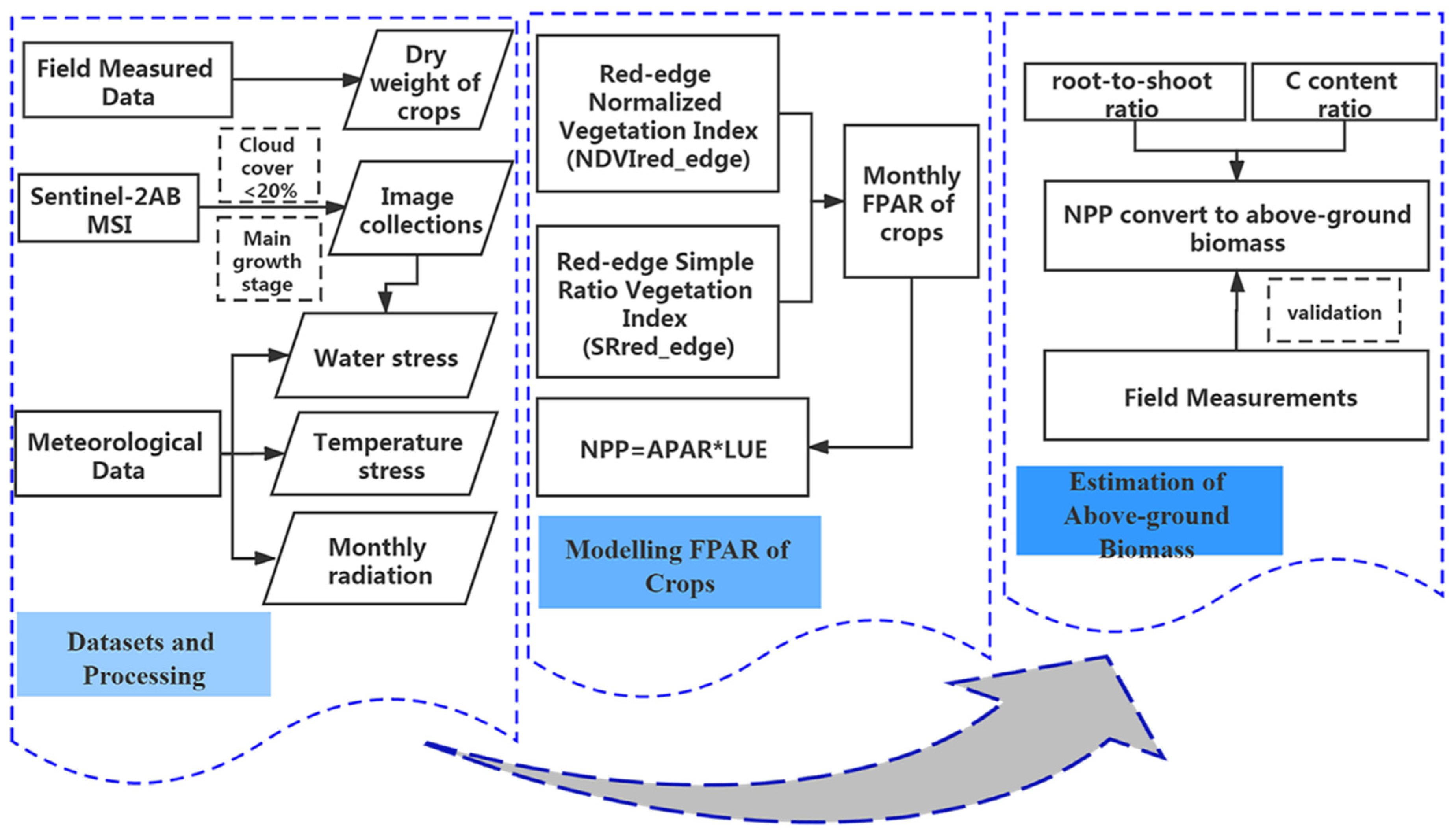

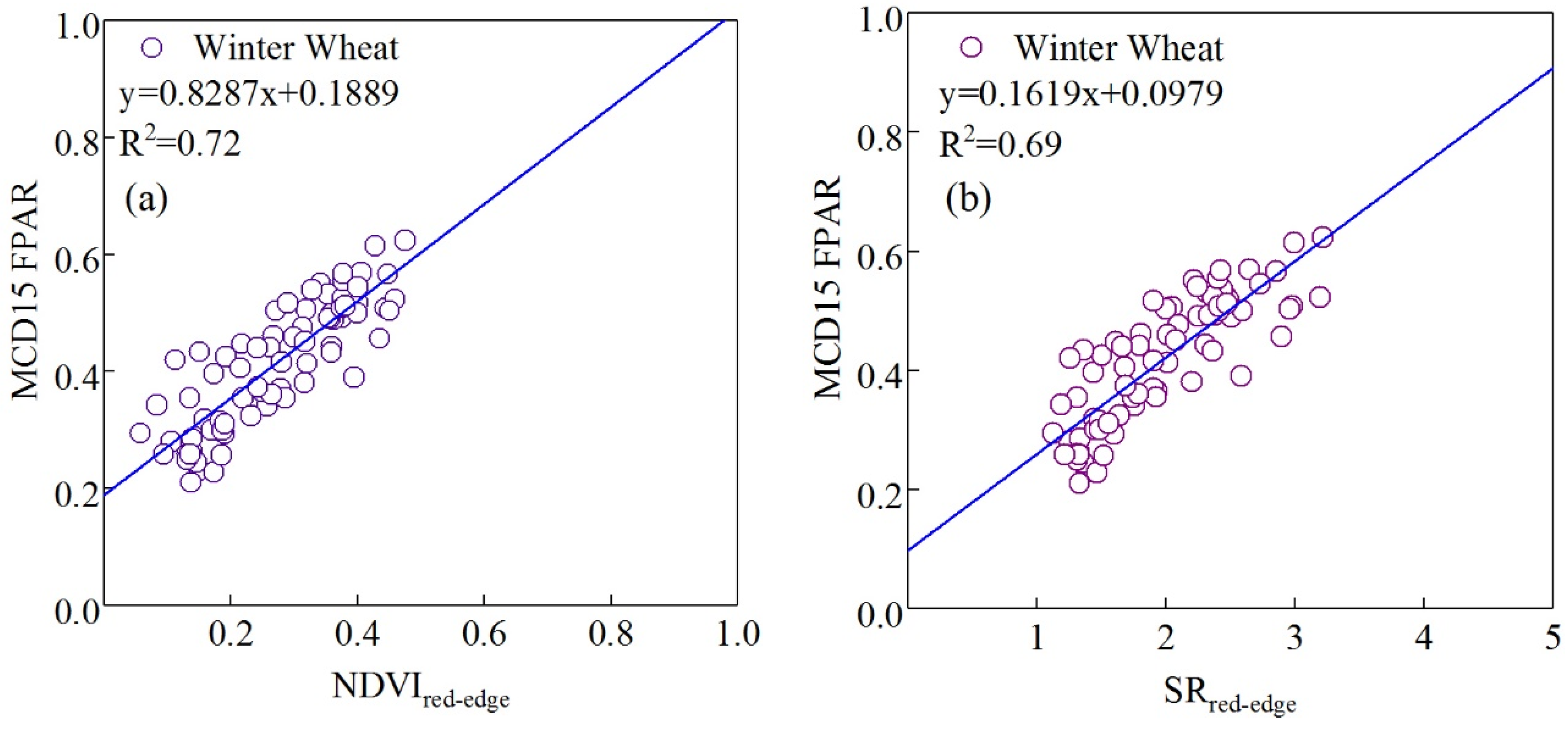
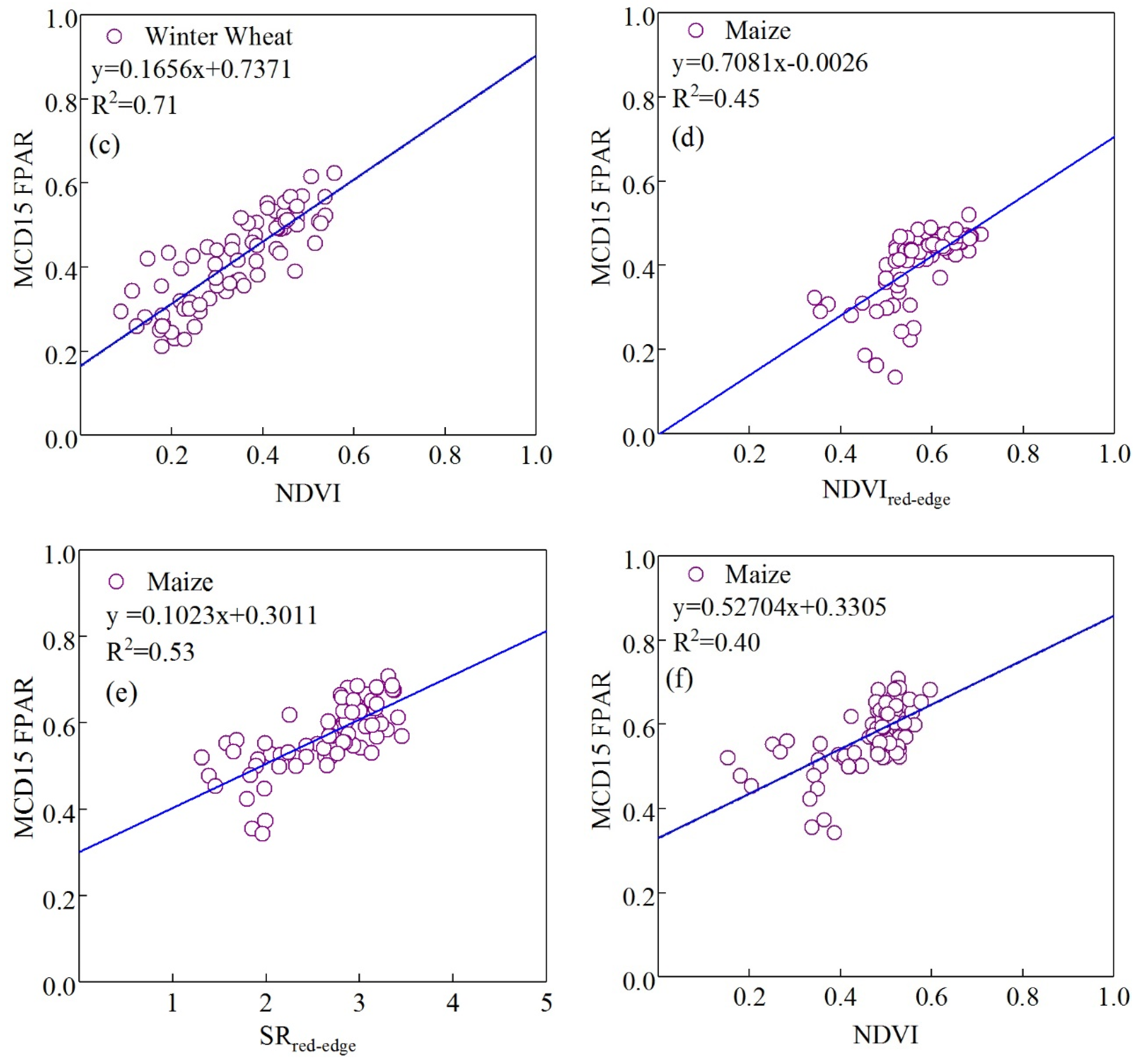
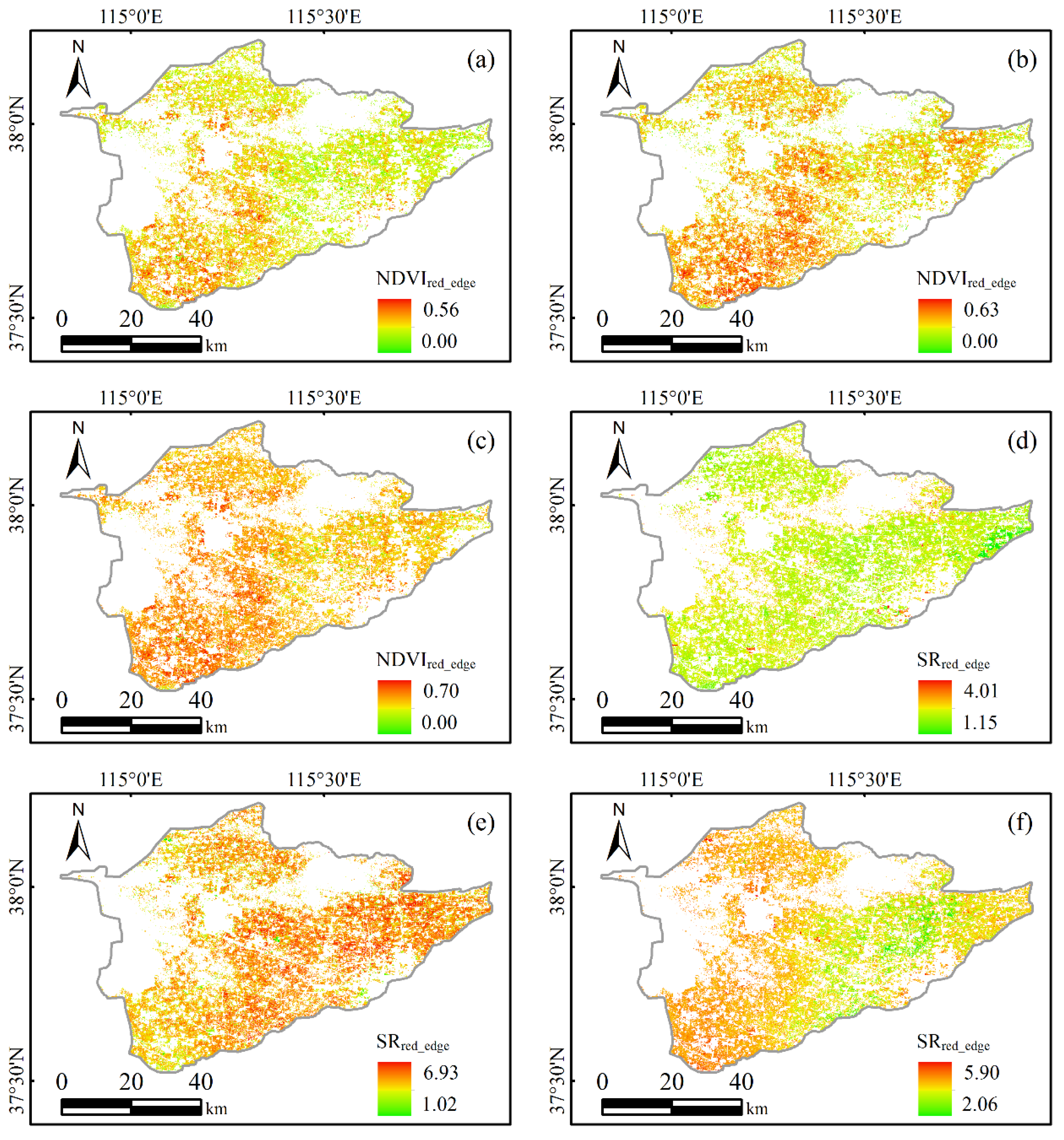
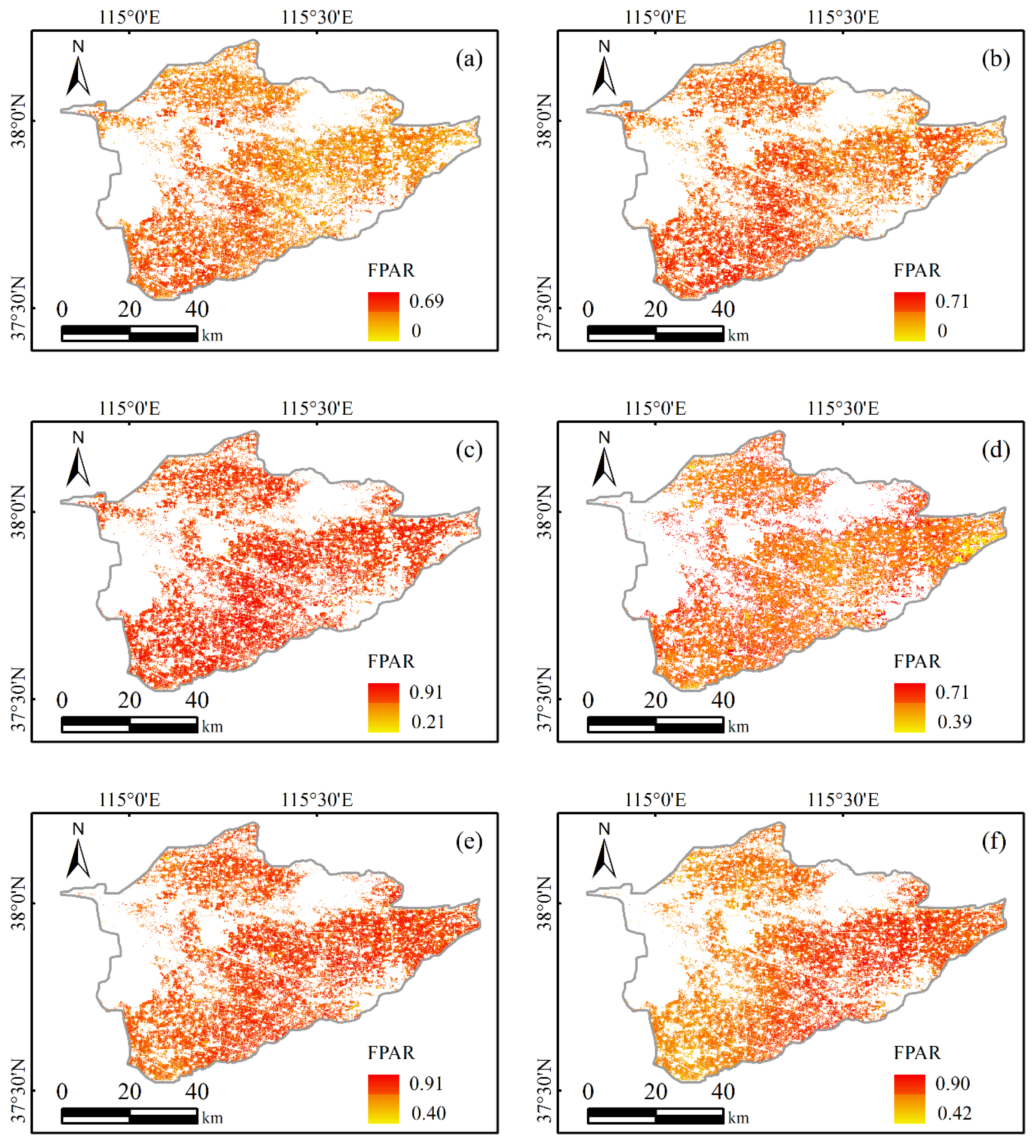
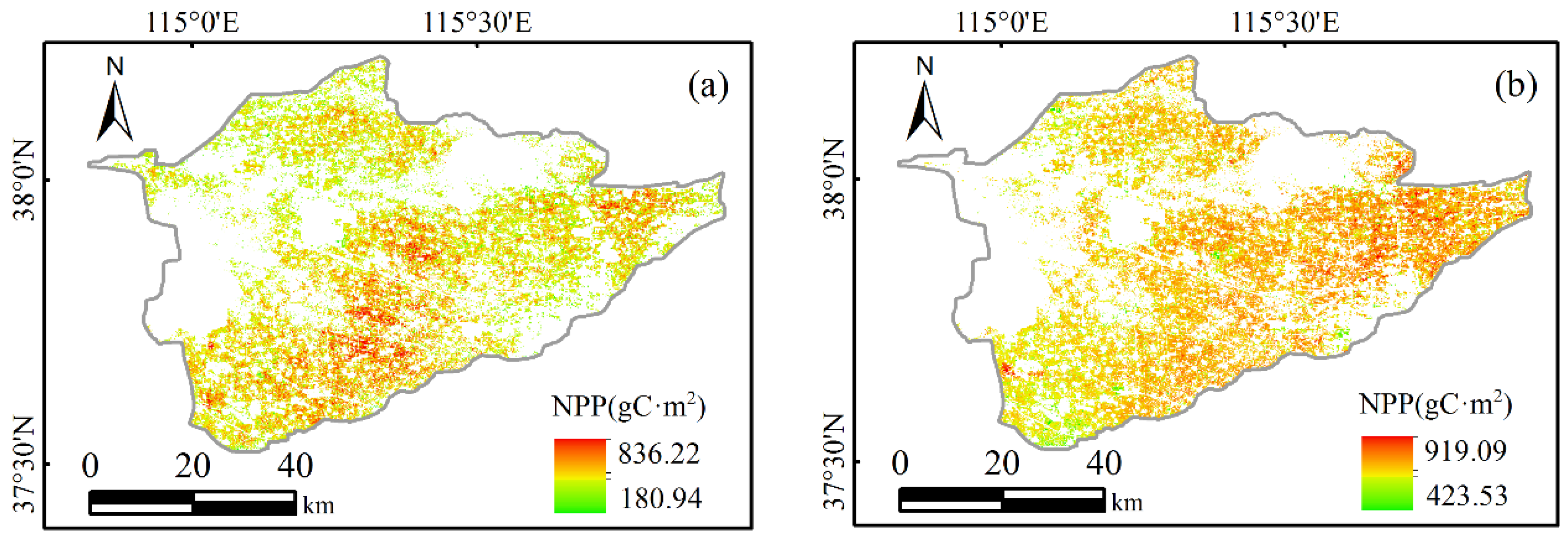

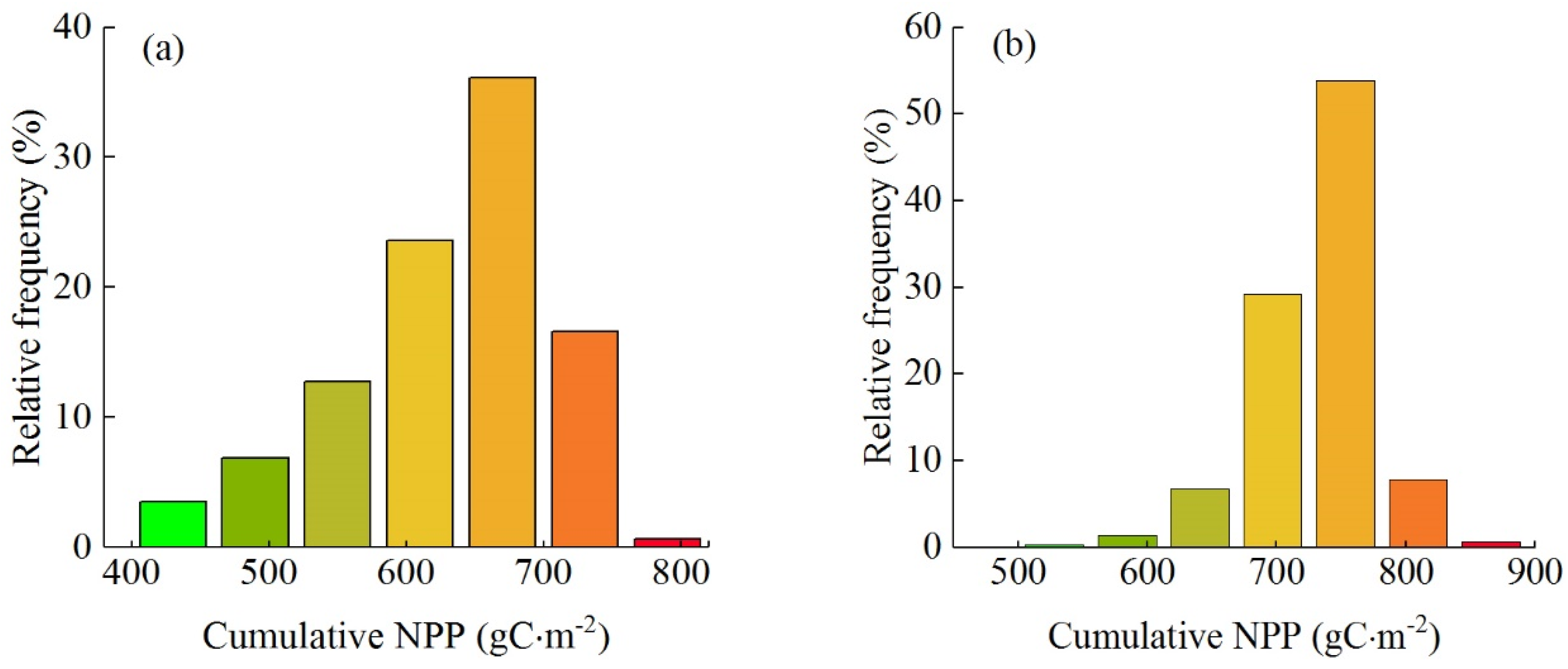
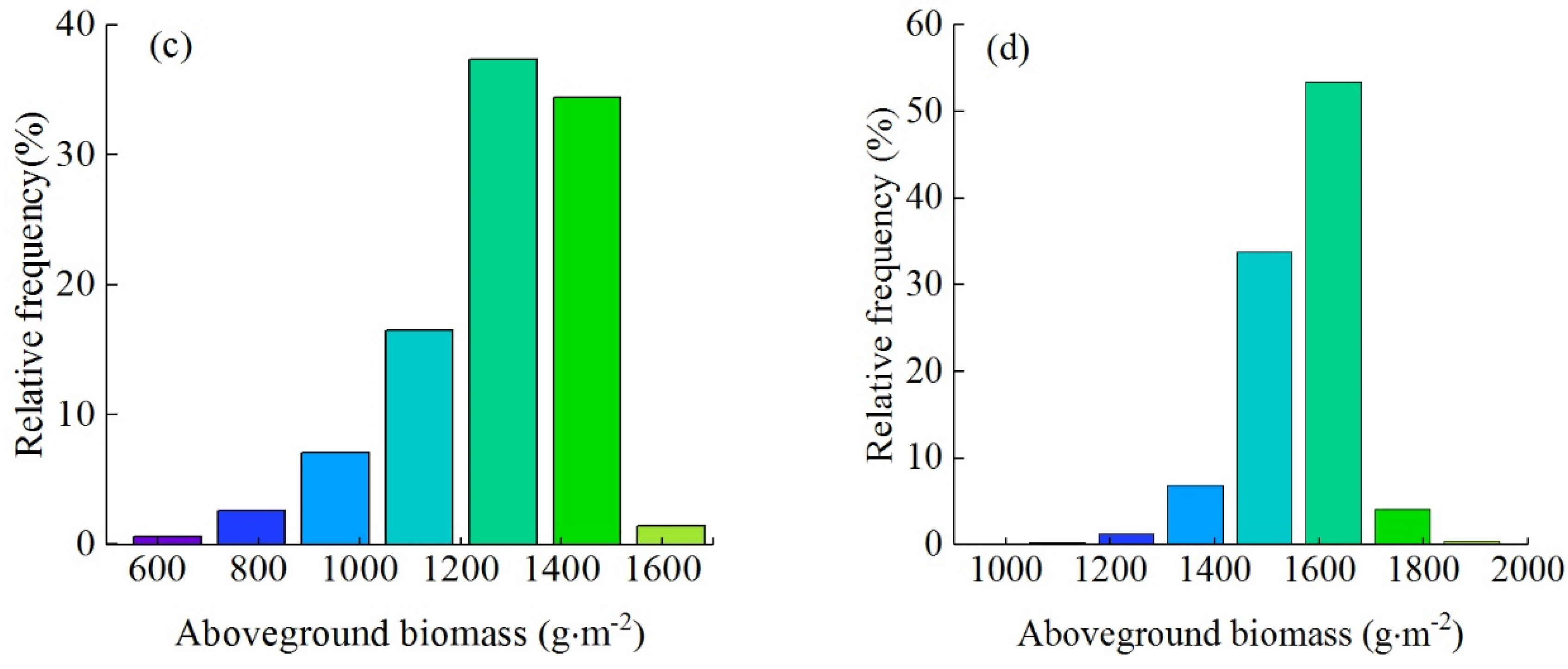
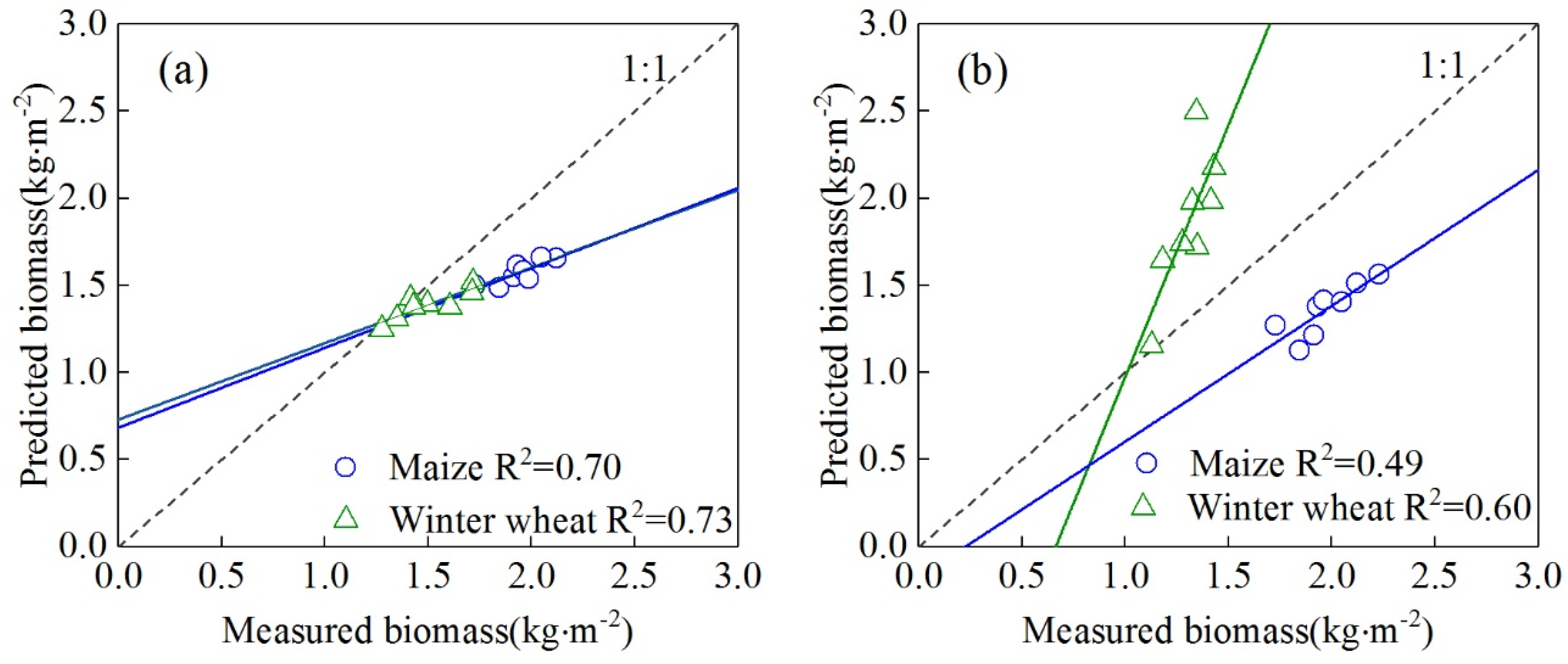
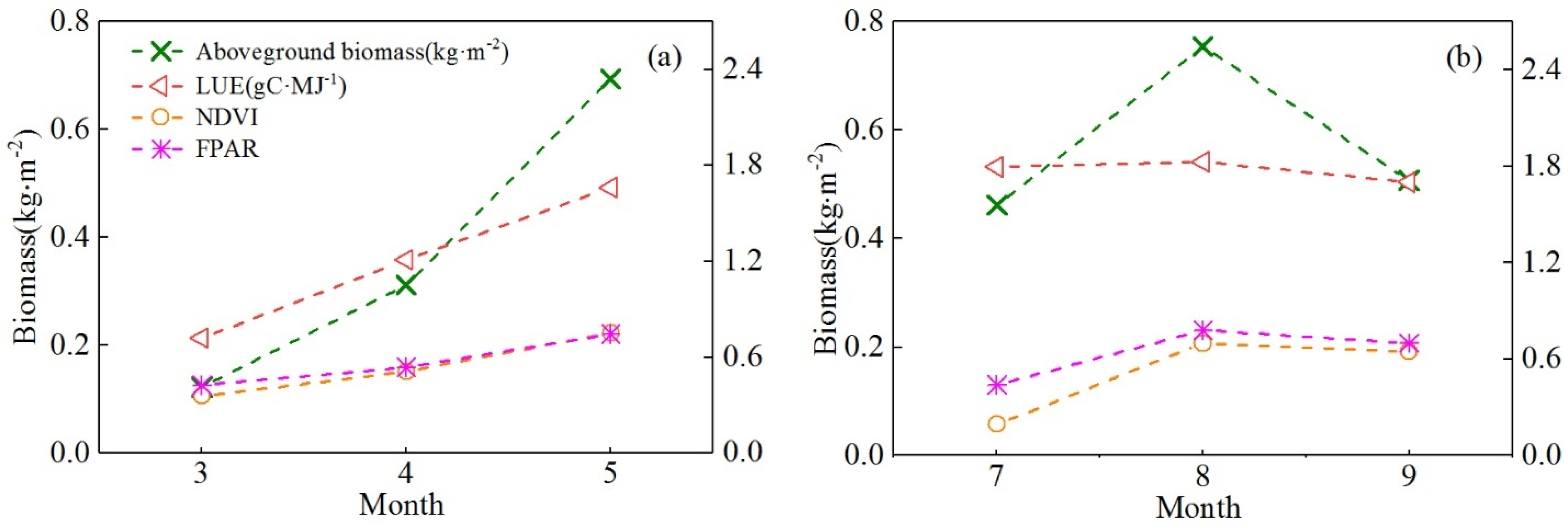

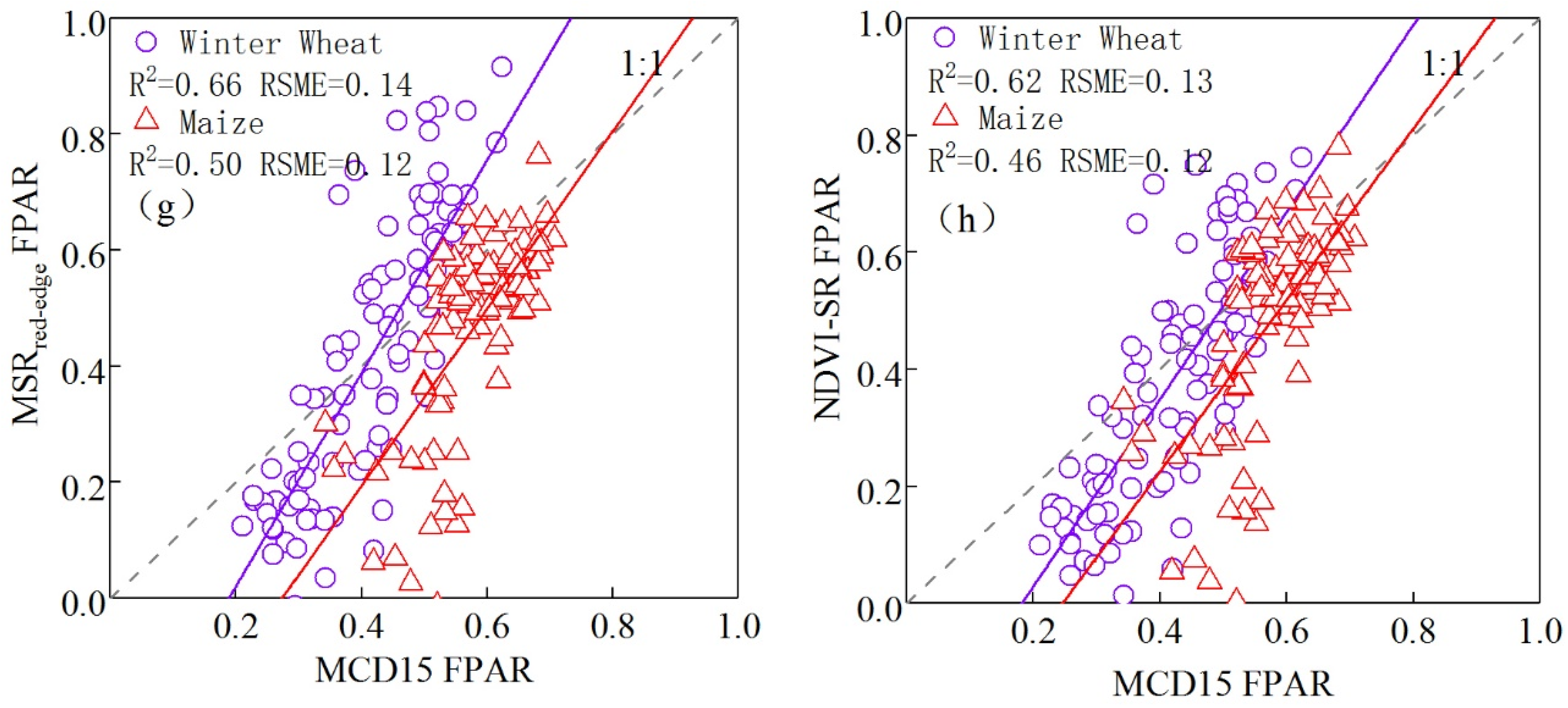
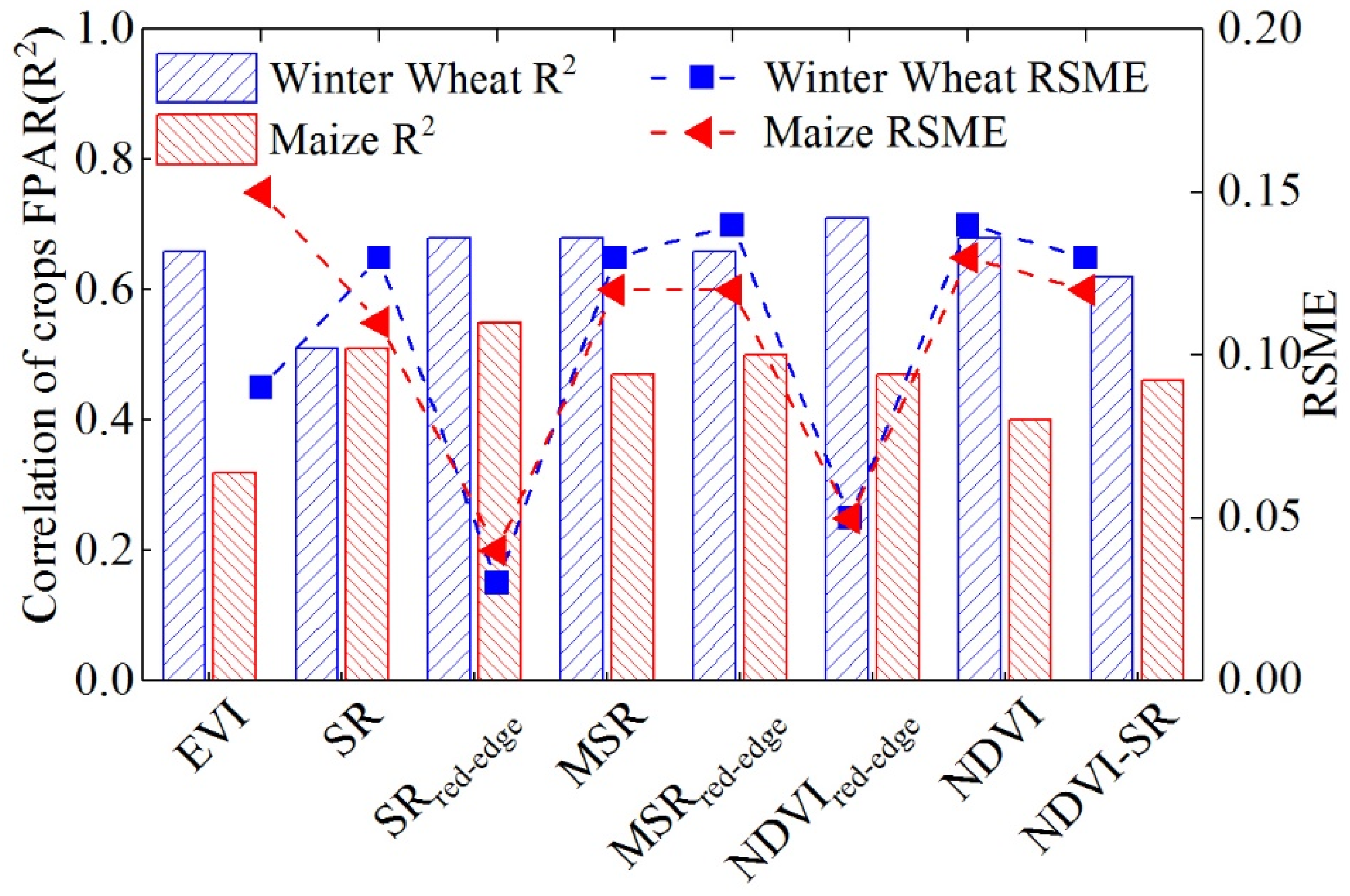

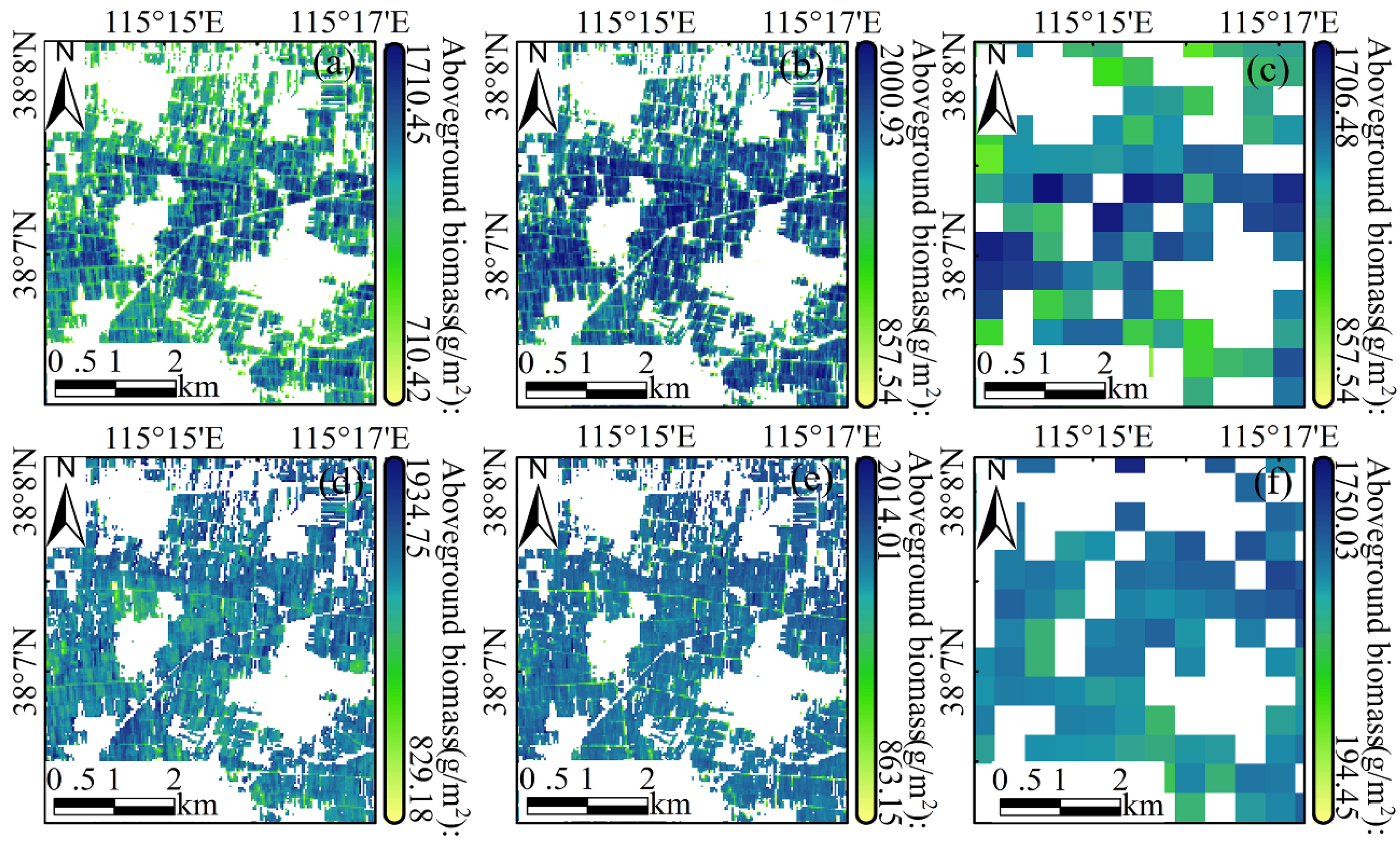
| Satellite Data | Band | Center Wavelength (nm) | Resolution (m) | Source |
|---|---|---|---|---|
| Sentinel-2 | B1 | 443 | 60 | European Space Agency (https://sentinel.esa.int/web/sentinel/, accessed on 6 November 2020) |
| B2 | 490 | 10 | ||
| B3 | 560 | 10 | ||
| B4 | 665 | 10 | ||
| B5 | 705 | 20 | ||
| B6 | 740 | 20 | ||
| B7 | 783 | 20 | ||
| B8 | 842 | 10 | ||
| B8A | 865 | 20 | ||
| B9 | 940 | 60 | ||
| B10 | 1375 | 60 | ||
| B11 | 1610 | 20 | ||
| B12 | 2190 | 20 | ||
| QA10 | — | 10 | ||
| QA20 | — | 20 | ||
| QA60 | — | 60 | ||
| MCD15A3H | FPAR | — | 500 | NASA LP DAAC at the USGS EROS Center (https://lpdaac.usgs.gov/products/mcd15a3hv006/, accessed on 6 November 2020) |
| LAI | — | 500 |
| Parameter | Unit | Description | Source |
|---|---|---|---|
| Meteorological Data | |||
| Temperature | °C | Near-surface (2 m) air temperature | China Meteorological Data Service Center (CMDSC) |
| Radiation | MJ/m2 | Surface downward shortwave radiation | Angstrom model |
| Measured Field Data | |||
| Winter Wheat Aboveground Biomass | g/m2 | Aboveground biomass at maturity stage | Field measurements |
| Summer Maize Aboveground Biomass | g/m2 | Aboveground biomass at maturity stage | Field measurements |
| Crops | Vegetation Indices | Regression Model | R2 |
|---|---|---|---|
| Winter wheat | y = 0.8287x + 0.1889 | 0.72 | |
| y = 0.1656x + 0.7371 | 0.71 | ||
| y = 0.1619x + 0.0979 | 0.69 | ||
| Maize | y = 0.7081x − 0.0026 | 0.45 | |
| y = 0.1023x + 0.3011 | 0.53 | ||
| y = 0.5270x + 0.3305 | 0.40 |
| Vegetation Indices | Descriptions | Equation | Reference | |
|---|---|---|---|---|
| It corrects for some atmospheric conditions and canopy background noise. | (5) | [40] | ||
| It can distinguish green leaves from other objects and estimate the relative biomass. | (6) | [41] | ||
| It is used to assess vegetation biomass and growth, which reduces the impact of atmosphere and topography. | (7) | [42] | ||
| It is an improved version of SR, which is sensitive to vegetation biophysical parameters. | (8) | [43] | ||
| It uses bands in the red edge and incorporates a correction for leaf specular reflection. | (9) | [44] | ||
| It is similar to NDVI but capitalizes on the sensitivity of the vegetation red edge to small changes in canopy chlorophyll. | (10) | [45] | ||
| Combined with red band and near infrared band, it has strong robustness in a wide range. However, it saturates in dense vegetation conditions. | (11) | [46] | ||
| Crops | Carbon Content Ratio | Dry Matter Ratio | Root-Shoot Ratio | Moisture Content (%) | |
|---|---|---|---|---|---|
| Economic Production | Residual Carbon Ratio | ||||
| Winter wheat | 0.39 | 0.49 | 0.85 | 0.11 | 12.5 |
| Maize | 0.39 | 0.47 | 0.78 | 0.09 | 13.5 |
Publisher’s Note: MDPI stays neutral with regard to jurisdictional claims in published maps and institutional affiliations. |
© 2021 by the authors. Licensee MDPI, Basel, Switzerland. This article is an open access article distributed under the terms and conditions of the Creative Commons Attribution (CC BY) license (https://creativecommons.org/licenses/by/4.0/).
Share and Cite
Fang, P.; Yan, N.; Wei, P.; Zhao, Y.; Zhang, X. Aboveground Biomass Mapping of Crops Supported by Improved CASA Model and Sentinel-2 Multispectral Imagery. Remote Sens. 2021, 13, 2755. https://doi.org/10.3390/rs13142755
Fang P, Yan N, Wei P, Zhao Y, Zhang X. Aboveground Biomass Mapping of Crops Supported by Improved CASA Model and Sentinel-2 Multispectral Imagery. Remote Sensing. 2021; 13(14):2755. https://doi.org/10.3390/rs13142755
Chicago/Turabian StyleFang, Peng, Nana Yan, Panpan Wei, Yifan Zhao, and Xiwang Zhang. 2021. "Aboveground Biomass Mapping of Crops Supported by Improved CASA Model and Sentinel-2 Multispectral Imagery" Remote Sensing 13, no. 14: 2755. https://doi.org/10.3390/rs13142755
APA StyleFang, P., Yan, N., Wei, P., Zhao, Y., & Zhang, X. (2021). Aboveground Biomass Mapping of Crops Supported by Improved CASA Model and Sentinel-2 Multispectral Imagery. Remote Sensing, 13(14), 2755. https://doi.org/10.3390/rs13142755








